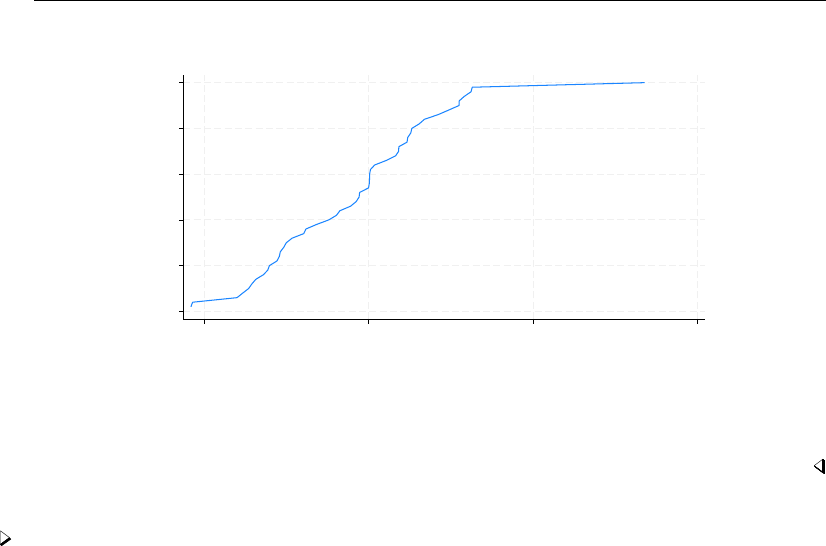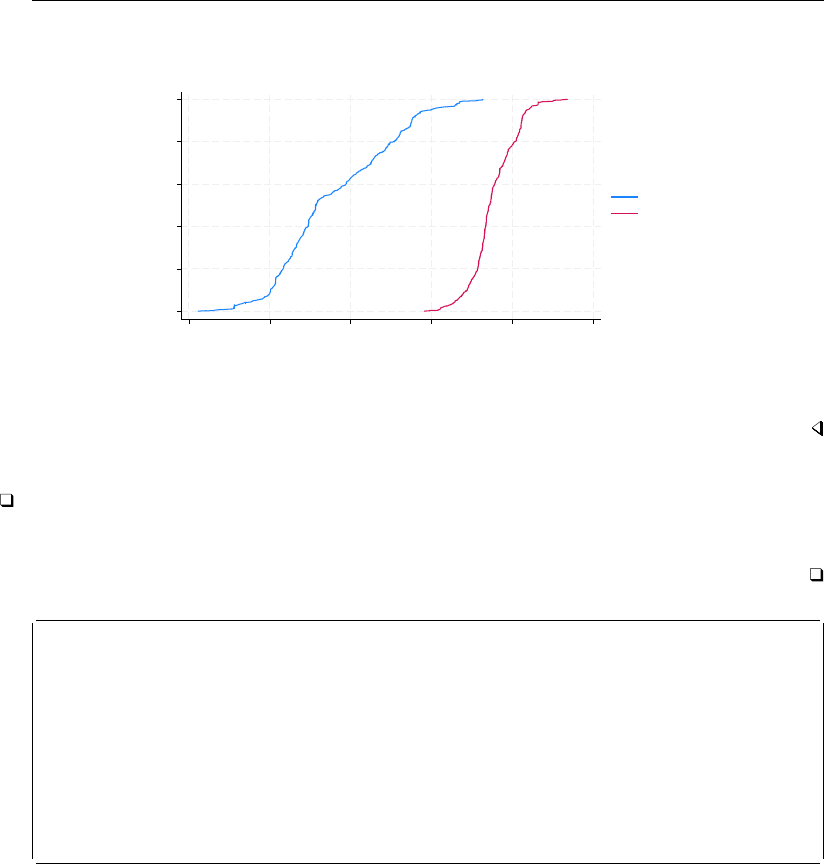
Title stata.com
cumul — Cumulative distribution
Description Quick start Menu Syntax
Options Remarks and examples Acknowledgment References
Also see
Description
cumul creates newvar, defined as the empirical cumulative distribution function of varname.
Quick start
Create new variable ecd containing the empirical cumulative distribution of v
cumul v, gen(ecd)
Use frequency as the unit for v to generate ecdf
cumul v, gen(ecdf) freq
Give equal values of v the same value in generated ecde
cumul v, gen(ecde) equal
Graph the empirical cumulative distribution of v
line ecd v, sort
Graph the distributions of variables v1 and v2
cumul v1, gen(ecd1) equal
cumul v2, gen(ecd2) equal
stack ecd1 v1 ecd2 v2, into(ecd v) wide clear
line ecd1 ecd2 v, sort
Menu
Statistics > Summaries, tables, and tests > Distributional plots and tests > Generate cumulative distribution
1

2 cumul — Cumulative distribution
Syntax
cumul varname
if
in
weight
, generate(newvar)
options
options Description
Main
∗
generate(newvar) create variable newvar
freq use frequency units for cumulative
equal generate equal cumulatives for tied values
∗
generate(newvar) is required.
by is allowed; see [D] by.
fweights and aweights are allowed; see [U] 11.1.6 weight.
Options
Main
generate(newvar) is required. It specifies the name of the new variable to be created.
freq specifies that the cumulative be in frequency units; otherwise, it is normalized so that newvar
is 1 for the largest value of varname.
equal requests that observations with equal values in varname get the same cumulative value in
newvar.
Remarks and examples stata.com
Example 1
cumul is most often used with graph to graph the empirical cumulative distribution. For instance,
we have data on the median family income of 957 US cities:
. use https://www.stata-press.com/data/r18/hsng
(1980 Census housing data)
. cumul faminc, gen(cum)
. sort cum
. line cum faminc, ytitle("") xlabel(, format(%6.0f))
> title("Cumulative of median family income")
> subtitle("1980 Census, 957 US cities")

cumul — Cumulative distribution 3
0
.2
.4
.6
.8
1
15000 20000 25000 30000
Median family inc., 1979
1980 Census, 957 US cities
Cumulative of median family income
It would have been enough to type line cum faminc, but we wanted to make the graph look better;
see [G-2] graph twoway line.
If we had wanted a weighted cumulative, we would have typed cumul faminc [w=pop] at the
first step.
Example 2
To graph two (or more) cumulatives on the same graph, use cumul and stack; see [D] stack. For
instance, we have data on the average January and July temperatures of 956 US cities:
. use https://www.stata-press.com/data/r18/citytemp, clear
(City temperature data)
. cumul tempjan, gen(cjan)
. cumul tempjuly, gen(cjuly)
. stack cjan tempjan cjuly tempjuly, into(c temp) wide clear
. line cjan cjuly temp, sort ytitle("") xtitle("Temperature (F)")
> title("Cumulatives:" "Average January and July temperatures")
> subtitle("956 US cities") legend(label(1 January) label(2 July))

4 cumul — Cumulative distribution
0
.2
.4
.6
.8
1
0 20 40 60 80 100
Temperature (F)
January
July
956 US cities
Cumulatives:
Average January and July temperatures
As before, it would have been enough to type line cjan cjuly temp, sort. See [D] stack for an
explanation of how the stack command works.
Technical note
According to Beniger and Robyn (1978), Fourier (1821) published the first graph of a cumulative
frequency distribution, which was later given the name “ogive” by Galton (1875).
Jean Baptiste Joseph Fourier (1768–1830) was born in Auxerre in France. As a young man,
Fourier became entangled in the complications of the French Revolution. As a result, he was
arrested and put into prison, where he feared he might meet his end at the guillotine. When
he was not in prison, he was studying, researching, and teaching mathematics. Later, he served
Napolean’s army in Egypt as a scientific adviser. Upon his return to France in 1801, he was
appointed Prefect of the Department of Is
`
ere. While prefect, Fourier worked on the mathematical
basis of the theory of heat, which is based on what are now called Fourier series. This work
was published in 1822, despite the skepticism of Lagrange, Laplace, Legendre, and others—who
found the work lacking in generality and even rigor—and disagreements of both priority and
substance with Biot and Poisson.
Acknowledgment
The equal option was added by Nicholas J. Cox of the Department of Geography at Durham
University, UK, who is coeditor of the Stata Journal and author of Speaking Stata Graphics.

cumul — Cumulative distribution 5
References
Beniger, J. R., and D. L. Robyn. 1978. Quantitative graphics in statistics: A brief history. American Statistician 32:
1–11. https://doi.org/10.2307/2683467.
Fourier, J. B. J. 1821. Notions g
´
en
´
erales, sur la population. Recherches Statistiques sur la Ville de Paris et le
D
´
epartement de la Seine 1: 1–70.
Galton, F. 1875. Statistics by intercomparison, with remarks on the law of frequency of error. Philosophical Magazine
49: 33–46. https://doi.org/10.1080/14786447508641172.
Wilk, M. B., and R. Gnanadesikan. 1968. Probability plotting methods for the analysis of data. Biometrika 55: 1–17.
https://doi.org/10.2307/2334448.
Also see
[R] Diagnostic plots — Distributional diagnostic plots
[R] kdensity — Univariate kernel density estimation
[D] stack — Stack data
Stata, Stata Press, and Mata are registered trademarks of StataCorp LLC. Stata and
Stata Press are registered trademarks with the World Intellectual Property Organization
of the United Nations. StataNow and NetCourseNow are trademarks of StataCorp
LLC. Other brand and product names are registered trademarks or trademarks of their
respective companies. Copyright
c
1985–2023 StataCorp LLC, College Station, TX,
USA. All rights reserved.
®
For suggested citations, see the FAQ on citing Stata documentation.
